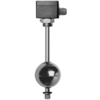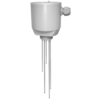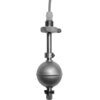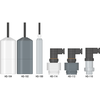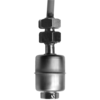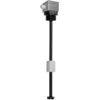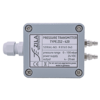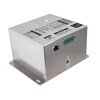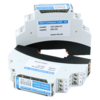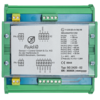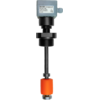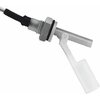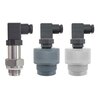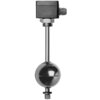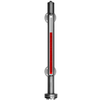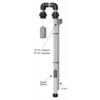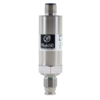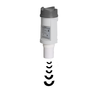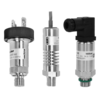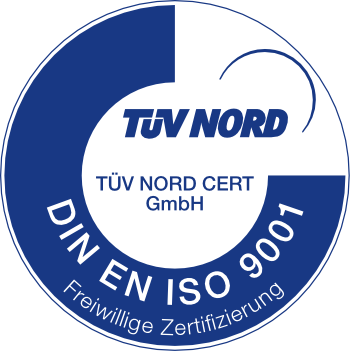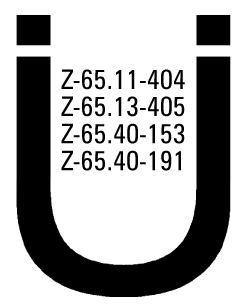Cart
EF 3…5 24 V configure
TK-300 configure
T-200.F Ex configure
Fluidix Lub-VDT configure
QFS-40 configure
HD-110 | HD-112 | HD-114 configure
MKL configure
TK-101 EX configure
LU-180 EX configure
ZT-V configure
LU-150 configure
T209-0
Immersible Magnetic Probe made of PVC, PE, PPH, PTFE or stainless steel (1.4571)
Magnetic immersion probes for use with highly aggressive liquid media for detecting level limits in containers
Properties
- connection : PO-Dose oder AA-Dose
- Protection class : IP 65 Dose
- Float type : max. 6x Kugel Edelstahl 105 mm Ø
- Sliding tube length : max. 6000 mm
- Operating temperature : max. 135 °C
- Operating pressure : max. 20 bar
- media density : 0,54 g/cm³
- Number of contacts : max. 7x Wechsler / max. 10x Schließer / 7x Öffner
- Switching current : 1A, 2A
- Switching capacity : Wechsler 60W/VA | Schließer 100 W/VA | Öffner 60 W/VA
- min. contact distance with several floats : 125 mm
EF 3…5 24 V
Conductive electrodes with 24 V DC direct connection
The conductive electrodes EF3...5 are approved by the "DIBt" as overfill prevention devices for liquids hazardous to water.
Properties
- connection : integrierter Anschlusskopf
- Protection class : IP 65
- connection thread : G 1¼"
- Material Screw connection : PPH
- Material electrode rods : Edelstahl (1.4571), Hastelloy C, Titan, Tantal
- material coating : PTFE
- Coating length : voll = ganzer Stab (10 mm am Stabende sind blank) teil = ca. 250 mm von oben
- Rod diameter : 4 mm, 6 mm
- rod length : max. 6 m
- Operating temperature : 85 °C
- Operating pressure : atmosphärisch
- Spacer : ab Länge > 1000 mm je 1000 mm 1 Abstandshalter
Properties electronic part
- Operating temperature : –20...+85 °C
- Storage temperature : –30...+85 °C
- nominal voltage : 24 V DC ± 15%
- Power consumption : max. 2 W (Klemme A1, A2)
- Switching voltage : max. 250 V AC, 150 V DC min. 5 V DC (Relais mit Kombi-Goldkontakten)
- Switching current : max. 3 A AC, 3 A DC min. 1 mA
- Switching capacity : max. 750 VA, 150 W
- Sensitivity : 3k ... 100 kΩ in vier Stufen (3 k, 10 k, 30 k, 100 kΩ) wählbar
T204-0.F
Immersible Magnetic Probe for Ex Zone 0 (Cat. 1)
The T20... magnetic immersion probes are used to detect fill level limits in containers for liquid media, where an explosive atmosphere of Zone 0 (Cat. 1) exists in the gas space above the liquid and an Ex-Zone 1 (Cat. 2) exists outside the container in the area of the junction box.
Properties
- connection : Kabel PUR blau
- Protection class : IP 68 Dose
- number of floats : max. 4x
- Operating temperature : max. 135 °C
- F-Contact : 1 / 12 kΩ
- Number of additional contacts : max. 3x Wechsler | 5x Schließer | 3x Öffner
- Switching current : 1 A, 2 A (nur mit Schirmung)
- Switching voltage : 230 V AC
Float
- Stainless steel ball 61 mm Ø : max. 20 bar | 0,65 g/cm³
- min. contact gap type 04 : 85 mm
Switching contacts and switching capacity
- Changeover contact : max. 3x | 60W/VA
- normally open : max. 5x | 100 W / VA
- Normally closed contact : max. 3x | 60 W/VA
HD-1XX
Hydrostatic filling level measurement
Continuous and precise level measurement in unpressurised, open basins and tanks as well as underground applications such as shafts, wells and boreholes.
T205-0.F
Ex area zone 0 (category 1)
The magnetic immersion probes T20... are used to detect fill level limit values in containers for liquid media, where an explosive atmosphere of zone 0 (cat. 1) is present in the gas space above the liquid and Ex zone 1 (cat. 2) is present outside the container, in the area of the junction box.
Properties
- Protection class EN60529 cable : IP 68
- connection cable : max. 10 Meter PUR
- Sliding tube length : Max. 6000 mm
- Operating temperature : max. 120 °C
- F-Contact : 1 / 12 kΩ
Float
- Stainless steel ball 44 mm Ø : max. 15 bar | 0,60 g/cm³
- Stainless steel cylinder 27 mm Ø : max. 10 bar | 0,78 g/cm³
TK-300
Level transducer
T30... continuous magnetic immersible probes are used for quasi-acquisition of the filling level in containers with liquid media.
Properties TK-300
- connection : Polyesterdose | Aluminiumdose | Stecker nach DIN 43650
- Protection class socket / plug : IP 65
- Protection class EN60529 cable : IP 55
- Float type : 10 (14)
- connection cable : 1000 mm LiYY 0,5 mm² oder Silikon 0,5 mm²
- Sliding tube length : max. 6000 mm
- Operating pressure : max. 6 bar
- Resolution : 10 mm, 15 mm oder 1%, 2%, 5% je nach Auflösung
- CE marking : siehe Konformitätserklärung
Operating temperature
- PV : max. 60°C
- PE : max 80 °C
- PP : max. 90°C
MaterialDensity
- Type 10 : 0,72 g/cm³
- Type 14 : 0,72 g/cm³
- Type 18 : 0,82 g/cm³
ZS-Serie
Differential pressure sensor for low pressure
Compact and robust differential pressure transmitter for measurement on air and other non-aggressive media
Properties
- Pressure type : Differenzdruck
- Housing : Aluminium
- medium : Luft und nicht aggressive Gase
Measurement parameters
- response time : < 2,5 s
- Hysteresis : 0,1 %
- Overload capacity : 4* fach bis 500 mbar, darüber 2* fach
- Signal output selection : 0...10 V | 4...20 mA, 2-Leiter
Operating conditions
- Operating voltage : 24 VDC/AC ±10 % (0...10 V) | 15...30 VDC (4...20 mA)
- Operating temperature : -20...+50 °C
Connections
- Electrical connection : Schraubklemme im Gehäuse
- Process connection : Schlauchanschluss 4 mm oder 6 mm
- Cable gland : PG 7
FluidIX Lub-6
Inline-capable oil condition sensor based on a multi-channel infrared measuring cell for permanent monitoring of the oil condition and prevention of machine damage
Based on non-dispersive infrared technology (NDIR), ZILA GmbH has developed an inline-capable measuring system that permanently monitors the oil condition directly in the system. The optical measuring system consists of a multi-channel infrared measuring cell with associated electronics and peripherals.
General information
- Housing : Robustes Aluminiumgehäuse
- Operating voltage : 18...36V DC (max. 400 mA @18V)
- Dimensions : 150 x 119 x 82 mm (L x B x H)
Operating conditions
- Operating temperature: : 0...+70 °C (optional 0...+90 °C)
- Maximum operating pressure: : 10 bar (optional 30 bar)
- Storage temperature: : -40...+90 °C
Connection
- ModBus TCP/IP : Ethernet-Port für Kommunikation über herstellerunabhängiges Busprotokoll
- Digital I/O ports : 1x Digital In 18...36V (10 mA max.), 4x Digital Out 18...36V (5 mA max.)
Operation
- User Interface : grafisch über Weboberfläche im eingebundenen Netzwerk
cIO CANopen Module
Compact I/O modules for DIN rail mounting
product series of compact CANopen I/O modules with various electrical connections
Properties
- Housing : Kunststoffgehäuse*
- Dimensions (LxBxH) : 18 x 90 x 62 mm
- Internal circuits : Ausgangsschutzschaltungen gegen Überspannung und elektrostasche Entladung
- Fieldbus and I/O level : getrennt durch galvanische Trennung
- ltdata.*zumAufrastenaufDIN-Trageschienen :
ElectricalConnection
- Operating voltage : 11...32V DC (typ. 24V DC)
- Operating temperature : 0...+55 °C
- Operating temperature : optional -40...+70 °C
- Conductor cross-section : 0,08...1,5 mm² (AWG28...AWG14)
CAN bus properties
- baud rate (max.) : 1 MBit
- ciA Standards : Ds301 Version 4.2 & DS401 Version 3.0
- ISO standards : ISO11898 (+ Transceiver TJA1050)
- PDO : siehe Dokumente
SG2420
Supply unit SG2420 for flow sensor
The DSM-2420 sensor can only be operated in hazardous areas with the associated SG2420 power supply unit or appropriately designed, approved Zener barriers.
Properties
- Housing : Kunststoff
- Protection class : IP00
- Ambient temperature : -20…+60°C
- Supply voltage : 24V DC +20% / -10%
T-200.F Ex
Overfill protection for containers with Ex approval
Level sensors type T-20_.F... are
approved by the DIBt (German
Institute for Structural Engineering) as liquid level limit switches for the overcharge protection of containers for storing water-dangerous liquids.
Connection
- Box : Ex-Polyester
- Box : Ex-Aluminium
Properties
- Protection class EN60529 : IP 65
- connection thread : G2"
- Union nut : G 2¾"
- Guide tube length : max. 6 m
- Operating temperature : -20…+60 °C
- Operating pressure : max. 6 bar je nach Ausführung
- media density : ρ ≥ 0,72 g/cm³ (je nach Schwimmertyp)
- Switching hysteresis : 2 mm
- Switching point tolerance : max. 2 mm
Resistance value
- Operational readiness : ca. 1 kΩ
- overfill alarm : ca. 12 kΩ
- Switching time : ca. 20 ms
- Ex-protection : siehe Baumusterprüfbescheinigung
- CE marking : siehe Konformitätserklärung
Fluidix Lub-VDT
Oil condition sensor for permanent monitoring of mechanical properties of liquids
The FluidIX Lub-VDT enables inline monitoring of mechanical fluid properties.
Properties
- CE marking : EN 61000-6-1/2/3/4
- Operating voltage : 9...32 V DC
- Housing material : Edelstahl
- Protection class : IP 67
- Dimensions : 30x90 mm
- Process connection : G 3/8"
- Electrical connection : M12-8 A-Coding
- Weight : 150g
- Measurement output : 2x 4...20mA
- bus protocol : ModbusRTU, CANopen
Measured variables
- Resonator frequency : 20...25 kHz
- Viscosity : 1-650 cSt (mm²/s)
- density : 0.5-1.5 g/cm³
- Temperature : -40...+125°C
- sampling rate : 1/s
Operating conditions
- Temperature of the fluid : -40...+125°C
- Housing temperature : -40...+100°C
- oil pressure : Max. 50 bar
- particle size : 250 μm
QFS-40
Built-in float level switch
The QFS-40 built-in float switch is designed for low-cost monitoring of liquids in containers.
Technical Data
- Switch housing : PPH| PVDF
- Seal : NBR (PPH) | FPM (PVDF)
- Operating temperature : PPH max. 80 °C| PVDF max. 100 °C
- Operating pressure : max. 10 bar
- Mounting position : horizontal (±30° von der Horizontalen)
- Contact assembly : Schliesser-, Öffnerkontakt (je nach Einbau)
- Electrical connection : PVC-Kabel
- Switching capacity : max. 230 V AC/DC| max. 40 VA, max. 2 A
- Contact resistance : max. 80 mW
- Min. electric strength : 400 V DC / 1 s
- Inductive/capacitive loads : Unbedingt Kontaktschutz vorsehen
- fluid density : PPH > 0,6 kg/dm³ | PVDF > 0,95 kg/dm³
- Protection class : IP 68
Connections
- external installation : G ½"
- internal installation : M16
HD-110 | HD-112 | HD-114
Hydrostatic screw-in probes (4...20mA | 0.8...10mWS)
Continuous and precise level measurement in unpressurised, open basins and tanks as well as underground applications such as shafts, wells and boreholes.
Properties
- Protection class EN60529 : IP 65
- Operating temperature : -10...70 °C
- Storage temperature : -25...70 °C
- Power supply : 15...30 V DC
- power : max. 25 mA
- Output : 2-Leiter-Technik | 4...20 mA
- Measuring range : 0,8...10 mWs (Standard)
- Overpressure : ca. 20 %
- Deviation from characteristic curve : Nichtlinearität,
- Insulation resistance : > 100 kΩ
- Short-circuit resistance : permanent
- Reverse polarity protection : keine Schädigung o. Funktion bei vertauschten Anschlüssen
Materials
- Housing : Edelstahl 1.4571, PVC, PVDF
- Measuring cell : Edelstahl 1.4404, Keramik AI2o3 96%, Keramik AI2o3 99,9%
- Seals : FKM (Viton ®), EPDM, FFKM (Kalrez ®)
- connection thread : G ¾“ | G 1 ½“
- Plug : Steckverbindung DIN 43650
T209-0.F
Magnetic immersion probe overfill protection for Ex zone 0 (Cat. 1)
The magnetic immersion probes T20... are used to detect fill level limit values in containers for liquid media, where an explosive atmosphere of zone 0 (cat. 1) is present in the gas space above the liquid and Ex zone 1 (cat. 2) is present outside the container, in the area of the junction box.
Properties
- connection : Polyesterdose, Aluminiumdose
- Protection class : IP 65 Dose
- Float type : Kugel Edelstahl 105 mm Ø
- Sliding tube length : max. 6000 mm
- Operating temperature : max. 135°C
- Operating pressure : max. 20 bar
- media density : 0,54 g/cm³
- F-Contact : 1 / 12 kΩ
- Number of additional contacts : 6x Wechsler, 9x Schließer, 6x Öffner
- Switching current : 1A, 2A ( nur mit Schirmung)
- Switching capacity : Wechsler: 60 W/VA, Schließer: 100 W/VA Öffner: 60 W/VA
- min. contact distance with several floats : 125 mm
MKL
Magnetic Flap Indicator
The MKL level indicator is connected by its two connections to the container to be monitored (see connection example). According to the law of interconnected containers the level in the float chamber corresponds exactly to the level in the container
Properties
- connection : Flansch ab DN 15
- Material : rostfreier Edelstahl, PVC, PPH, PVDF
- Material flange : Edelstahl 1.4571, C22.8
- Material Float : Edelstahl, Titan, PVC, PPH, PVDF
- Number of contacts : beliebig
- Contact load : max 10 VA, max 230 V AC
- Display length : max. 6m
Operating temperature
- PTFE seal : max. 150 °C
- Stainless steel: Klingerit seal : max. 200 °C
- PVC : max. 60 °C
- PPH : max. 90 °C
- PVDF : max. 130 °C
Stainless steel float
- Weight : ~ 300 g
- Dimensions : Ø 52 x 270
- Operating pressure : 16 bar
- media density : ρ ≥ 0,70 g/cm³
Stainless steel float
- Weight : ~ 320 g
- Dimensions : Ø 52 x 270
- Operating pressure : 40 bar
- media density : ρ ≥ 0,75 g/cm³
Titanium float
- Weight : ~ 180 g
- Dimensions : Ø 52 x 150
- Operating pressure : 16 / 40 bar
- media density : ρ ≥ 0,73 g/cm³
PVC float
- Weight : ~ 331 g
- Dimensions : Ø 52 x 250
- Operating pressure : 6 bar
- media density : ρ ≥ 0,8 g/cm³
PPH float
- Weight : ~ 283 g
- Dimensions : Ø 52 x 250
- Operating pressure : 6 bar
- media density : ρ ≥ 0,69 g/cm³
PVDF float
- Weight : ~ 352 g
- Dimensions : Ø 52 x 250
- Operating pressure : 6 bar
- media density : ρ ≥ 0,85 g/cm³
TK-101 EX
Measuring transducer (R/I-transducer)
The measuring transducer Tk101 and Tk101Ex are built directly into the connection boxes of our Liquid Level Measuring Instruments of type TK-30.
Properties
- Operating temperature : -20...+60 °C
- Storage temperature : -40...+80 °C
- Ex-protection : siehe Zertifikat
- CE marking : siehe Konformitätserklärung
Input
- Resistance range in three-wire circuit : 4...10 kΩ
- Measuring current : 0,8 mA @ RE = 4 kΩ
- Measuring current : 0,33 mA bei RE = 10 kΩ
- Measuring voltage : 3,3 V
Supply/Output
- 2-wire : 4...20 mA
- Voltage(Um) : 11...28 V DC
- Burden / load : 0...800 Ω |RBürde max = [(Um - Um min) / 0,02] Ω
- Output signal in case of error : max. 24 mA
Fault influences
- Max. Total error : ± 1 %
- Temperature influence : -0,015 % / °C
- Supply voltage influence : 0,025 % / V
Setting range
- Full deflection : 60...105 %
- Zero point adjustment : 0...25 %
DTS-CAN
Flexible, digital pressure and temperature sensor with CAN bus
Media-immersed, flush-mounted, stainless steel pressure-temperature sensor with CAN bus
Properties
- Operating voltage : 9...27V
- Power consumption : 35 mA typ (50 mA max)
- Dimensions : 75x22 mm
- Process connection : G 1/4“
Measuring range
- Temperature : -20…+100 °C
- ltdata.Druck : (-1) 0…100 bar
- ltdata.AbweichungDruck : max +/- 0,5 % FS @ 0-10°C
- ltdata. :
LU-180 EX
Compact Ultrasonic Level Sensor
The LU-150 is a short-range integrated ultrasonic level transmitter, intrinsically safe as Ex-version LU-180. This general purpose, 2 wire, 4 to 20 mA loop powered transmitter is ideal for liquids, slurries, and bulk materials in open or closed vessels to 5 m (16.4 ft).
Properties
- Protection class EN60529 : IP 68
- Power supply : 12...30 V DC / 0.1A Spitze
- Power consumption : Max. 0,75 W (25 mA bei 24 V DC)
- Output : 4...20 mA
- Max. Load : 600 Ω bei 24 V DC
- Measuring span : Proportional oder umgekehrt proportional
- Measurable materials : Flüssigkeiten, Schlämme, Schuttgüter
- operating temperature : –20...+60 °C
- Opening angle : 12°
- working pressure : Atmosphärisch
- Display : 3-stelliges LCD
- Process connection : Gewinde G 2" (BSPP) EN 10226 PVDF
- Weight : 1,3 Kg
- Cable entry : Kabelverschraubung M 20 x 1.5
- Material housing electronics : Polybutylenterephthalat PBT
- Material sensor / thread : PVDF-Copolymer
Input
- Measuring range : 0,25...5,0 m
- frequency : 54 kHz
Measuring Accuracy
- Measurement deviation : ± 0,25 % vom Messbereich (in Luft)
- Resolution : 3 mm
- Temperature compensation : im Sensor integriert
- Echo processing : „Sonic Intelligence“ von Siemens
ZT-V
Reliable pressure measurement and optimum process monitoring with the ZT series
From low to high pressure and suitable for liquid and gaseous media.
Connection
- Signal output : 0...10 V, 3-Leiter | 0,5...4,5, ratiometrisch | 4...20 mA, 2-Leiter
- Electrical connection : DIN EN 175301-803 A | DIN EN 175301-803 C | Binder M12x1 (Serie 713)
- Process connection : G 1/4" ISO 1179-2 (Male Form E) | 1/4" NPT | 7/16" 20 UNF Male
- measuring range (bar) : 0…0,6 | 0…600
Properties
- Pressure type : Relativdruck | Absolutdruck
- Housing : Edelstahl
- Overpressure : 1,5* fach bis 400 bar, darüber 1,2* fach
- Bursting pressure : 3* fach bis 600 bar, darüber 1,5* fach
Measurement parameters
- response time : < 1 ms
- Total error : ≤ 0,5 % FS
- Non-linearity : ≤ 0,2 % FS
- Non-repeatability : ≤ 0,10 % FS
- Hysteresis : ≤ 0,15 % FS
ambient conditions
- Temperature of the fluid : -40...+125 °C (0...+80 °C kompensierter Bereich)
- Ambient temperature : -40...+105 °C
- Storage temperature : -40°C...+125°C
- Shock resistance : g 1000 gemäß IEC 60068-2-32
- Vibration resistance : g 20 gemäß IEC 60068-2-6
LU-150
Compact Ultrasonic Level Sensor
The LU-150 is a short-range integrated ultrasonic level transmitter, intrinsically safe as Ex-version LU-180. This general purpose, 2 wire, 4 to 20 mA loop powered transmitter is ideal for liquids, slurries, and bulk materials in open or closed vessels to 5 m (16.4 ft).
Properties
- Protection class EN60529 : IP 68
- Power supply : 12...30 V DC / 0.1A Spitze
- Power consumption : Max. 0,75 W (25 mA bei 24 V DC)
- Output : 4...20 mA
- Max. Load : 600 Ω bei 24 V DC
- Measuring span : Proportional oder umgekehrt proportional
- Measurable materials : Flüssigkeiten, Schlämme, Schuttgüter
- operating temperature : –20...+60 °C
- Opening angle : 12°
- working pressure : Atmosphärisch
- Display : 3-stelliges LCD
- Process connection : Gewinde G 2" (BSPP) EN 10226 PVDF
- Weight : 1,3 Kg
- Cable entry : Kabelverschraubung M 20 x 1.5
- Material housing electronics : Polybutylenterephthalat PBT
- Material sensor / thread : PVDF-Copolymer
Input
- Measuring range : 0,25...5,0 m
- frequency : 54 kHz
Measuring Accuracy
- Measurement deviation : ± 0,25 % vom Messbereich (in Luft)
- Resolution : 3 mm
- Temperature compensation : im Sensor integriert
- Echo processing : „Sonic Intelligence“ von Siemens
Our application engineers advise you personally, comprehensively and professionally!
Simply contact us by phone or e-mail!
